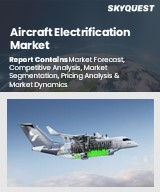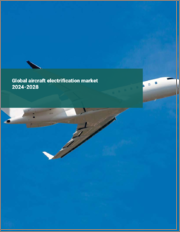
|
시장보고서
상품코드
1628246
항공기 전기화 시장 기회, 성장 촉진요인, 산업 동향 분석, 예측(2025-2034년)Aircraft Electrification Market Opportunity, Growth Drivers, Industry Trend Analysis, and Forecast 2025 - 2034 |
||||||
2024년 83억 달러로 평가된 세계 항공기 전기화 시장은 2025년부터 2034년까지 14.2%의 CAGR로 성장할 것으로 예상됩니다.
이러한 성장의 주요 원동력은 전 세계적으로 환경 문제에 대한 관심이 높아짐에 따라 항공 업계가 지속가능성과 탄소 배출량 감소에 초점을 맞추고 있다는 점입니다. 항공사, 정부, 승객 모두 친환경적인 여행 옵션을 우선시하고 있으며, 이는 친환경 기술에 대한 수요 증가로 이어지고 있습니다. 저배출과 재생에너지 통합의 잠재력을 가진 전기 항공기는 이러한 변화의 흐름에서 중요한 기업이 되고 있습니다.
세계 각국 정부는 기후 변화 대응을 위해 더욱 엄격한 규제를 도입하고 있으며, 이는 전기 항공기와 하이브리드 항공기의 채택을 더욱 촉진하고 있습니다. 이러한 규제에는 탄소세, 배출량 상한제, 순배출량 제로 목표 등이 포함됩니다. 이러한 정책은 항공 산업 내 기술 혁신을 촉진하고 제조업체와 항공사가 규정 준수 기준을 충족하기 위해 더 깨끗한 기술을 추구하도록 유도합니다. 이러한 규제에 따라 전기 추진 시스템이 개발되고 항공사는 정부 정책에 맞춰 항공기를 조정하여 보다 지속가능한 항공으로의 전환을 가속화하고 있습니다.
항공기 전기화 시장은 배터리, 태양전지, 전기 액추에이터, 연료전지, 발전기, 모터, 전기 펌프, 전력 전자, 배전 장치 등 여러 구성요소로 나눌 수 있습니다. 이 중 전기 모터 분야가 가장 큰 시장 점유율을 차지하여 2024년에는 21.3% 차지할 것입니다. 전기 모터는 전기 추진을 발전시키는 데 매우 중요하며 항공에 경량, 고효율, 고신뢰성 솔루션을 제공합니다. 제조업체들은 항공기의 성능을 향상시키기 위해 모터의 출력 밀도를 높이고 에너지 소비를 줄이기 위해 점점 더 많은 노력을 기울이고 있습니다.
| 시장 범위 | |
|---|---|
| 시작 연도 | 2024년 |
| 예측 연도 | 2025-2034년 |
| 시작 금액 | 83억 달러 |
| 예상 금액 | 307억 달러 |
| CAGR | 14.2% |
지역 및 도시 항공 모빌리티의 견인력이 증가함에 따라 모터 기술 혁신이 더욱 중요해지고 있습니다. 특히 전기 수직이착륙(eVTOL) 항공기를 위한 확장 가능한 전기 모터에 대한 수요가 증가하고 있습니다. 이러한 소형 소형 모터는 가볍고 에너지 효율이 높은 설계로 단거리 비행을 위한 지속가능한 솔루션을 제공합니다. 배터리 기술이 발전함에 따라 전기 모터는 리저널 제트기에서 대형 민간항공기에 이르기까지 다양한 항공기에 충분한 추력을 제공할 수 있을 것으로 기대됩니다.
기술 측면에서 시장은 하이브리드 전기, 전기, 완전 전기의 세 가지 부문으로 나뉩니다. 하이브리드 전기 부문이 가장 빠르게 성장하고 있으며, CAGR은 14.5%로 예측됩니다. 하이브리드 전기 비행기는 기존 엔진과 전기 추진력을 결합하여 완전 전기 비행기가 항속거리에서 어려움을 겪을 수 있는 장거리 지역 비행을 위한 실용적인 솔루션을 제공합니다. 이 기술은 연료 소비와 배출을 줄이고 보다 지속가능한 항공으로 가는 과도기적 경로를 제공합니다. 배터리 기술이 계속 발전하면 하이브리드 전기 항공기의 상업적 활용이 더욱 현실화될 것으로 보입니다.
북미 항공기 전기화 시장은 2034년까지 115억 달러를 넘어설 것으로 예상됩니다. 이 지역에서는 탄소 배출량 감축을 위한 연방 정부의 규제와 자금 지원 이니셔티브에 힘입어 항공기 전기화 개발이 크게 진전되고 있습니다. 미국과 캐나다는 모두 항공기 전기화 분야에서 큰 진전을 이루고 있으며, 항공우주 산업은 이러한 노력을 가속화하기 위해 협력 관계를 구축하고 있습니다.
목차
제1장 조사 방법과 조사 범위
제2장 주요 요약
제3장 업계 인사이트
- 생태계 분석
- 밸류체인에 영향을 미치는 요인
- 이익률 분석
- 파괴
- 향후 전망
- 제조업체
- 유통업체
- 공급업체 상황
- 이익률 분석
- 주요 뉴스
- 규제 상황
- 영향요인
- 성장 촉진요인
- 지속가능하고 친환경적인 항공 기술에 대한 수요 상승
- 항공 업계의 이산화탄소 배출량 절감을 추진하는 정부 규제
- 비행 거리 연장을 가능하게 하는 배터리 기술의 진보
- 연비 효율적인 전기항공기 솔루션에 투자하는 항공사
- 운항·보수 비용 절감에 대한 주목 상승
- 업계의 잠재적 리스크와 과제
- 높은 초기 개발비와 인프라 투자 비용
- 한정된 충전 인프라가 전기항공기 보급을 방해
- 성장 촉진요인
- 성장 가능성 분석
- Porters 분석
- PESTEL 분석
제4장 경쟁 구도
- 소개
- 기업 점유율 분석
- 경쟁 포지셔닝 매트릭스
- 전략 전망 매트릭스
제5장 시장 추정과 예측 : 구성요소별, 2021-2034년
- 주요 동향
- 배터리
- 니켈 기반
- 납축 기반
- 리튬 기반
- 연료전지
- 태양전지
- 전동 액추에이터
- 전동 펌프
- 발전기
- 모터
- 파워 일렉트로닉스
- 배전 기기
제6장 시장 추정과 예측 : 기술별, 2021-2034년
- 주요 동향
- 전기자동차
- 하이브리드
- 솔라
- 배터리 구동
- 연료전지
- 완전 전동
제7장 시장 추정과 예측 : 용도별, 2021-2034년
- 주요 동향
- 발전
- 배전
- 전력 변환
- 에너지 저장
제8장 시장 추정과 예측 : 지역별, 2021-2034년
- 주요 동향
- 북미
- 미국
- 캐나다
- 유럽
- 영국
- 독일
- 프랑스
- 이탈리아
- 스페인
- 러시아
- 아시아태평양
- 중국
- 인도
- 일본
- 한국
- 호주
- 라틴아메리카
- 브라질
- 멕시코
- 중동 및 아프리카
- 남아프리카공화국
- 사우디아라비아
- 아랍에미리트
제9장 기업 개요
- AMETEK, Inc.
- Astronics Corporation
- BAE Systems
- Crane Aerospace & Electronics
- EaglePicher Technologies LLC
- EnerSys
- General Electric
- Honeywell International Inc.
- Lee Air, Inc.
- magniX
- Meggitt PLC
- PBS Aerospace
- Radiant Power Corporation
- Raytheon Technologies
- Safran
- Thales Group
The Global Aircraft Electrification Market, valued at USD 8.3 billion in 2024, is projected to grow at a CAGR of 14.2% from 2025 to 2034. This growth is largely driven by the aviation industry's increasing focus on sustainability and reducing carbon emissions as environmental concerns continue to rise worldwide. Airlines, governments, and passengers are all prioritizing eco-friendly travel options, leading to an increased demand for green technologies. Electric aircraft, with their potential for lower emissions and renewable energy integration, are becoming key players in this shift.
Governments across the globe are introducing stricter regulations to combat climate change, which further fuels the adoption of electric and hybrid aircraft. These regulations include carbon taxes, emissions caps, and net-zero emissions targets. These policies encourage innovation within the aviation industry, pushing manufacturers and airlines to seek cleaner technologies to meet compliance standards. In response to these regulations, electric propulsion systems are being developed, and airlines are aligning their fleets to meet government policies, accelerating the transition to more sustainable aviation.
The aircraft electrification market can be broken down into several components, such as batteries, solar cells, electric actuators, fuel cells, generators, motors, electric pumps, power electronics, and distribution devices. Among these, the electric motors segment holds the largest market share, accounting for 21.3% in 2024. Electric motors are critical in advancing electric propulsion, offering lightweight, high-efficiency, and reliable solutions for aviation. Manufacturers are increasingly focused on enhancing motor power density and reducing energy consumption to improve aircraft performance.
| Market Scope | |
|---|---|
| Start Year | 2024 |
| Forecast Year | 2025-2034 |
| Start Value | $8.3 Billion |
| Forecast Value | $30.7 Billion |
| CAGR | 14.2% |
As regional and urban air mobility gains traction, there is a greater emphasis on motor technology innovation. The demand for scalable electric motors, particularly for electric vertical takeoff and landing (eVTOL) aircraft, is growing. These smaller, compact motors are designed to be lightweight and energy-efficient, providing sustainable solutions for short-haul flights. As battery technology progresses, electric motors are expected to generate enough thrust for a wider range of aircraft, from regional jets to larger commercial planes.
Regarding technology, the market is divided into three segments: hybrid electric, more electric, and fully electric. The hybrid electric segment is the fastest-growing, with a projected CAGR of 14.5%. Hybrid-electric aircraft combine conventional engines with electric propulsion, offering a practical solution for longer regional flights where fully electric planes may struggle with range. This technology reduces fuel consumption and emissions, providing a transitional path to more sustainable aviation. As battery technology continues to advance, hybrid-electric aircraft will become more viable for commercial use.
The North America aircraft electrification market is expected to exceed USD 11.5 billion by 2034. The region is seeing significant progress in electric aircraft development, supported by federal regulations and funding initiatives aimed at reducing carbon emissions. Both the U.S. and Canada are making strides in the electrification of aircraft, with the aerospace industry fostering collaborations to accelerate these efforts.
Table of Contents
Chapter 1 Methodology & Scope
- 1.1 Market scope & definitions
- 1.2 Base estimates & calculations
- 1.3 Forecast calculations
- 1.4 Data sources
- 1.4.1 Primary
- 1.4.2 Secondary
- 1.4.2.1 Paid sources
- 1.4.2.2 Public sources
Chapter 2 Executive Summary
- 2.1 Industry synopsis, 2021-2034
Chapter 3 Industry Insights
- 3.1 Industry ecosystem analysis
- 3.1.1 Factor affecting the value chain
- 3.1.2 Profit margin analysis
- 3.1.3 Disruptions
- 3.1.4 Future outlook
- 3.1.5 Manufacturers
- 3.1.6 Distributors
- 3.2 Supplier landscape
- 3.3 Profit margin analysis
- 3.4 Key news & initiatives
- 3.5 Regulatory landscape
- 3.6 Impact forces
- 3.6.1 Growth drivers
- 3.6.1.1 Increasing demand for sustainable and eco-friendly aviation technologies
- 3.6.1.2 Government regulations pushing for reduced carbon emissions in aviation
- 3.6.1.3 Advancements in battery technology enabling longer flight ranges
- 3.6.1.4 Airlines investing in fuel-efficient electric aircraft solutions
- 3.6.1.5 Rising focus on reducing operating and maintenance costs
- 3.6.2 Industry pitfalls & challenges
- 3.6.2.1 High initial development and infrastructure investment costs
- 3.6.2.2 Limited charging infrastructure hindering widespread electric aircraft adoption
- 3.6.1 Growth drivers
- 3.7 Growth potential analysis
- 3.8 Porter's analysis
- 3.9 PESTEL analysis
Chapter 4 Competitive Landscape, 2024
- 4.1 Introduction
- 4.2 Company market share analysis
- 4.3 Competitive positioning matrix
- 4.4 Strategic outlook matrix
Chapter 5 Market Estimates & Forecast, By Components, 2021-2034 (USD Million)
- 5.1 Key trends
- 5.2 Batteries
- 5.2.1 Nickel-based
- 5.2.2 Lead acid based
- 5.2.3 Lithium-based
- 5.3 Fuel cells
- 5.4 Solar cells
- 5.5 Electric actuators
- 5.6 Electric pumps
- 5.7 Generators
- 5.8 Motors
- 5.9 Power electronics
- 5.10 Distribution devices
Chapter 6 Market Estimates & Forecast, By Technology, 2021-2034 (USD Million)
- 6.1 Key trends
- 6.2 More electric
- 6.3 Hybrid electric
- 6.3.1 Solar powered
- 6.3.2 Battery powered
- 6.3.3 Fuel Cell powered
- 6.4 Fully electric
Chapter 7 Market Estimates & Forecast, By Application, 2021-2034 (USD Million)
- 7.1 Key trends
- 7.2 Power generation
- 7.3 Power distribution
- 7.4 Power conversion
- 7.5 Energy storage
Chapter 8 Market Estimates & Forecast, By Region, 2021-2034 (USD Million)
- 8.1 Key trends
- 8.2 North America
- 8.2.1 U.S.
- 8.2.2 Canada
- 8.3 Europe
- 8.3.1 UK
- 8.3.2 Germany
- 8.3.3 France
- 8.3.4 Italy
- 8.3.5 Spain
- 8.3.6 Russia
- 8.4 Asia Pacific
- 8.4.1 China
- 8.4.2 India
- 8.4.3 Japan
- 8.4.4 South Korea
- 8.4.5 Australia
- 8.5 Latin America
- 8.5.1 Brazil
- 8.5.2 Mexico
- 8.6 MEA
- 8.6.1 South Africa
- 8.6.2 Saudi Arabia
- 8.6.3 UAE
Chapter 9 Company Profiles
- 9.1 AMETEK, Inc.
- 9.2 Astronics Corporation
- 9.3 BAE Systems
- 9.4 Crane Aerospace & Electronics
- 9.5 EaglePicher Technologies LLC
- 9.6 EnerSys
- 9.7 General Electric
- 9.8 Honeywell International Inc.
- 9.9 Lee Air, Inc.
- 9.10 magniX
- 9.11 Meggitt PLC
- 9.12 PBS Aerospace
- 9.13 Radiant Power Corporation
- 9.14 Raytheon Technologies
- 9.15 Safran
- 9.16 Thales Group














